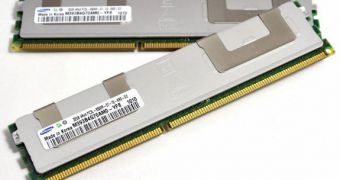Technology usually advances at a steady pace, with the graphics, memory, storage and connectivity standards rising bit by bit. However, on certain occasions, one company or another comes forth with a new invention or a breakthrough that can change the way a certain field of expertise is approached. Samsung could be said to have achieved something in between these two extremes, having announced that its first 32GB DDR3 memory modules have started sampling.
The 32GB beastly RDIMMs have the highest density in the industry and are based on dual-die 40nm class 4Gb DRAMs. Specifically, a 32GB module is made up of 36 such DRAMs, has a frequency of 1,066MHz and likely operates on 1.35V (the L in PC3L seems to suggest low-voltage operation).
This means that, at a low power, two-way servers and four-way servers can achieve memory capacities of 384GB and 2TB memory, respectively. Not only that but, thanks to the higher density and lower power consumption, the 32GB memory modules will enable a performance increase of 33% and a power consumption reduction of 40% compared to systems that achieve the same amount of memory with 16GB modules.
"Samsung continues to set the pace in advanced memory for high-end server applications by offering 40nm-class 32GB memory modules to reach previously unattainable levels of system capacity," Soo-In Cho, president and general manager of Samsung Electronics' Memory Division, said. "In just 10 months, Samsung has now secured the best competitive advantage with the broadest portfolio of 40nm-class DDR3 based memory solutions in the industry since the 40nm-class DRAM was first produced last July."
Unfortunately, servers and data centers will have to wait a while before they can upgrade, as Samsung's 40nm process technology-based 32GB RDIMM will only enter the stage of mass production in April. Prices are still a mystery at this point.

 14 DAY TRIAL //
14 DAY TRIAL //